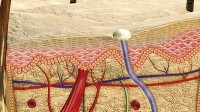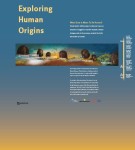It has a bill like a duck, leg spurs like a rooster, lays eggs like a reptile, but has fur like a mammal. Yet all these features elegantly integrate to form the body of a modern platypus. If God created the platypus, then why couldn’t He create other creatures that seem to have borrowed parts from other familiar forms? He may have done just that when he made Chilesaurus. More… …read more Read more here: icr.org
By Creation Moments Behold the giant oarfish – a creature of which legends are made. With its snake-like body that can grow up to fifty-six feet in length, the longest bony fish in existence has inspired countless legends about sea serpents. read more …read more Read more here: Creation Moments
By John C. P. Smith Indeed, the very reason Jesus came into the world was as a result of the great love of Israel’s God, and on a mission to fully express His mercy. …read more Read more here: AIG Daily
By Avery Foley That’s why Richard Dawkins despises young-earth creationists—he recognizes the incredible threat they are to his atheistic religion. …read more Read more here: AIG Daily
The poet George Santayana once said, “Those who cannot learn from history are doomed to repeat it.” In the life of every nation, there are “memories” that must be preserved if that nation is to retain an awareness of its unique role among the nations of the world—indeed, among the long list of nations throughout history. More… …read more Read more here: icr.org
By Creation Moments One of the most interesting artifacts at the British Museum is the Lycurgus Cup, a beautiful goblet made by the Romans sixteen hundred years ago. The cup depicts the story of King Lycurgus, entangled in grapevines for his treachery against Dionysus, the god of wine in Greek mythology. read more …read more Read more here: Creation Moments
By Ken Ham Nearly every time I post an update on the exciting Ark Encounter project, there seem to be those habitual complainers who claim the money should be spent on the poor instead and not be “wasted” this way. Before I address that, it is interesting to note that there are many projects underway in this nation that cost as much or enormous amounts more than the Ark Encounter. For instance, this project in Louisiana is costing about the same as the Ark project: Students at Louisiana State University will soon be able to soak up the sun in [More]
By Dr. Andrew A. Snelling Only one place on Earth holds a treasure trove of precious opals—Australia’s Outback. …read more Read more here: AIG Daily
By Ken Ham We all know what a Venus Fly Trap is, and we’re captivated as we watch it snap shut and “swallow” insects. But do you know why this incredible plant needs these insects? And were you aware that there are many varieties of these “carnivorous” plants? Some of them catch insects, or even small frogs or mammals. Others act like flypaper and catch insects on a sticky fluid. There are even some that build up a vacuum chamber that sucks in small creatures when the trap is triggered. Image by Tristan Gillingwater [CC BY-SA 2.0 (http://creativecommons.org/licenses/by-sa/2.0)], reproduced from [More]
By Creation Moments How many times have you seen headlines proclaiming that “Sixty billion planets in the Milky Way could support life” or “One hundred billion planets in our galaxy may harbor complex life”? It seems that the numbers change with each new announcement. Where did those numbers come from in the first place? read more …read more Read more here: Creation Moments
By REALdeal Source: Watch the First 21 Days of a Bee’s Life in Under a Minute For more content like this visit REALfarmacy.com. Photographer Anand Varma first became interested in bees when National Geographic asked him to do a photo shoot for a story. From that point on Anand started keeping bees in his backyard. Long story short, Anand was awakened to the reality of Varroa destructor, the bee-decimating parasitic mite. He became determined to help solve this [&hellip Source: Watch the First 21 Days of a Bee’s Life in Under a Minute Learn more at <a class="colorbox" rel="nofollow" …read [More]
By Avery Foley Bill Nye recently said, “We’re all the same . . . from a scientific standpoint there’s no such thing as race”—a biblical, not an evolutionary, view of humanity. …read more Read more here: AIG Daily
By Dr. David Menton Skin’s multilayered design provides us with the perfect combination of strength, flexibility, and durability. …read more Read more here: AIG Daily
By Multimedia On this episode of ID the Future, learn about some of scientists’ latest attempts to copy sophisticated designs found in the natural world. This emerging science of imitating nature, known as biomimetics, has attracted extensive research and led to new technologies. As uniform experience has shown, such good design comes not from blind processes, but from a good mind. Your browser does not support playing Audio, please upgrade your browser or find our podcast on podOmatic Download Episode …read more Read more here: id the future
His Salon magazine article recognizes how the Bible paved the way for radical change but he still gets his facts wrong. …read more Read more here: creation.com
Computer modelling that has led to dire warnings about climate change is built on questionable understanding of cloud behaviour. …read more Read more here: creation.com
By Ken Ham The famous Smithsonian in Washington, DC, is sending a new traveling exhibit across the United States. This exhibit, taken from the David H. Koch Hall of Human Origins in the National Museum of Natural History, located in Washington, DC, is called “Exploring Human Origins: What Does It Mean to Be Human?” Apparently the director hopes that this exhibit will “spark a respectful and positive conversation across the country about what it means to be human and inspire people to contemplate their place in the natural world.” The Smithsonian reports the exhibit “will highlight key milestones in the [More]
By Creation Moments Are you superstitious? A Harris poll conducted early in 2014 found that: 21 percent of Americans believe that knocking on wood prevents bad luck; 20 percent wouldn’t dream of walking under a ladder; 14 percent believe it’s unlucky to open an umbrella indoors; and 12 percent think the number 13 is unlucky. In fact, 14 percent of Americans said they believe Friday the 13th is an unlucky day. read more …read more Read more here: Creation Moments
By Ken Ham Our religious liberties in America have been quickly eroding as our culture becomes increasingly intolerant of those who stand for biblical values. Well, Democratic presidential candidate Hillary Clinton’s campaign has reportedly said that “Hillary will fight to make it easier, not more difficult, for women and families to get ahead and ensure that women are not discriminated against for personal medical decisions.” And Clinton allegedly said in a recent speech that “Yes, we’ve cut the maternal mortality rate in half, but far too many women are still denied critical access to reproductive health . . . . [More]
By Ken Ham On May 12, President Obama, during a panel discussion for the Catholic-Evangelical Summit on Overcoming Poverty at Georgetown University, made remarks on poverty at this Washington, DC-based school. You can read the full text of the panel discussion on the White House website. Secular and Christian media have reported on this panel discussion. I wanted to single out just some of the comments President Obama made and respond briefly to them in regard to the President’s inconsistencies concerning his blatant disregard for Scripture. At one stage the President referred to “my own Christian faith.” During the discussion [More]
We answer the questions: Will heaven be boring with no sin? And, how did people start interpreting the Bible to allow for homosexuality? …read more Read more here: creation.com
By Multimedia On this episode of ID the Future, Casey Luskin concludes his series discussing the top 10 problems with biological and chemical evolution. This series is based upon Casey Luskin’s chapter in the volume More than Myth, edited by Paul Brown and Robert Stackpole (Chartwell Press, 2014). In this segment, Casey discusses a bonus eleventh problem: that humans display many behavioral and cognitive ability that offer no apparent survival advantage. Your browser does not support playing Audio, please upgrade your browser or find our podcast on podOmatic Download Episode …read more Read more here: id the future
By Ken Ham Scientists have great hopes of someday creating artificial intelligence (AI) that can learn in a similar way to humans. This theme is popular in many movies, but often in these films the robots turn into destructive machines that take over the world and try to wipe out or enslave humanity. Bertram Malle of Brown University recently wrote an opinion piece for LiveScience that provides his potential solution for how to create moral robots if we were to someday achieve this level of technology. His proposed solution involves creating robots that can learn proper behavior from those around [More]
A few years ago, scientists discovered a unique sensory organ in the jaw of a rorqual whale—the world’s largest creature. Rorqual whales, which include the blue whale and fin whale, feed by ballooning out folds of tissue that bag gobs of krill from fertile ocean waters. Some of those researchers recently described the unique bungee-cord-like nerve fibers that illustrate clever and intentional design. More… …read more Read more here: icr.org
By Multimedia On this episode of ID the Future, Casey Luskin discusses recent findings on convergent evolution that conflict with typical evolutionary thinking. Darwinian evolution is supposed to have no goal, but convergent evolution implies that, against all odds, species are evolving the same complex traits — over and over again. Is this “surprising” conclusion best explained within Darwinian theory, or the intelligent design paradigm? Listen in and decide. Your browser does not support playing Audio, please upgrade your browser or find our podcast on podOmatic Download Episode …read more Read more here: id the future
By Ken Ham Some secularists keep saying that the Creation Museum is hurting for attendance and that no one will be coming to visit anymore, but I don’t know what they’re talking about! Recently, in a single day we had more than 900 guests at the museum just from school groups alone. That’s a lot of young people! You can always tell when the school groups are here because you can see many of them in their matching colored t-shirts so that their teachers can keep track of them. And keep in mind, the public schools don’t bring groups of [More]






































